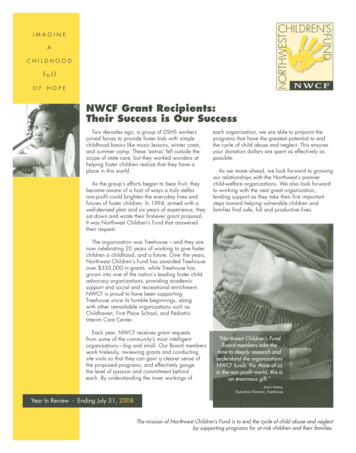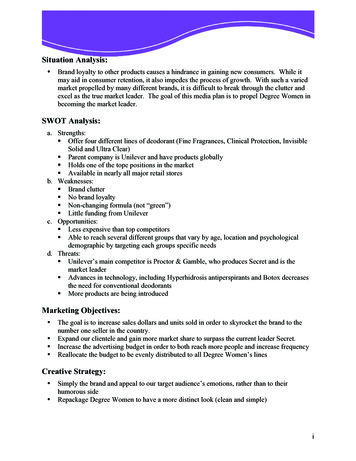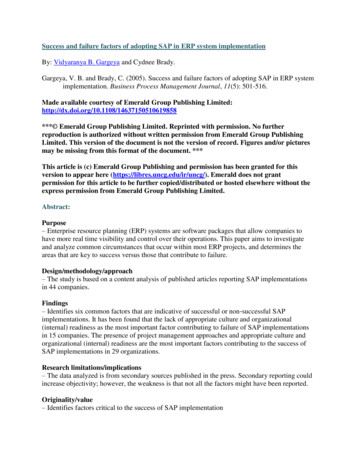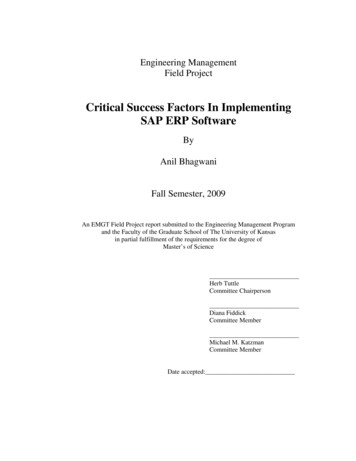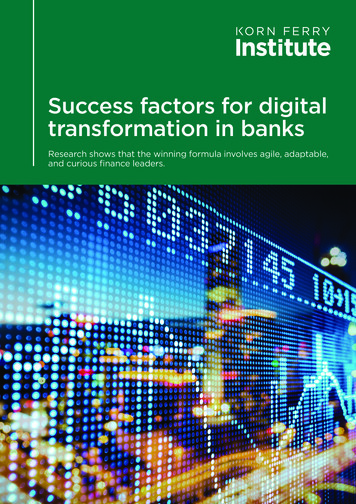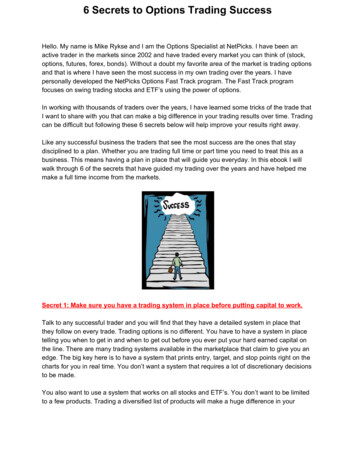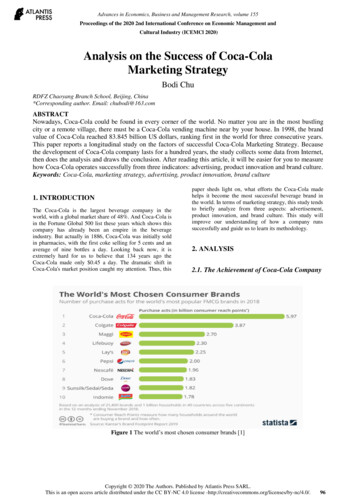
Transcription
Advances in Economics, Business and Management Research, volume 155Proceedings of the 2020 2nd International Conference on Economic Management andCultural Industry (ICEMCl 2020)Analysis on the Success of Coca-ColaMarketing StrategyBodi ChuRDFZ Chaoyang Branch School, Beijing, China*Corresponding author. Email: chubodi@163.comABSTRACTNowadays, Coca-Cola could be found in every corner of the world. No matter you are in the most bustlingcity or a remote village, there must be a Coca-Cola vending machine near by your house. In 1998, the brandvalue of Coca-Cola reached 83.845 billion US dollars, ranking first in the world for three consecutive years.This paper reports a longitudinal study on the factors of successful Coca-Cola Marketing Strategy. Becausethe development of Coca-Cola company lasts for a hundred years, the study collects some data from Internet,then does the analysis and draws the conclusion. After reading this article, it will be easier for you to measurehow Coca-Cola operates successfully from three indicators: advertising, product innovation and brand culture.Keywords: Coca-Cola, marketing strategy, advertising, product innovation, brand culture1. INTRODUCTIONThe Coca-Cola is the largest beverage company in theworld, with a global market share of 48%. And Coca-Cola isin the Fortune Global 500 list these years which shows thiscompany has already been an empire in the beverageindustry. But actually in 1886, Coca-Cola was initially soldin pharmacies, with the first coke selling for 5 cents and anaverage of nine bottles a day. Looking back now, it isextremely hard for us to believe that 134 years ago theCoca-Cola made only 0.45 a day. The dramatic shift inCoca-Cola's market position caught my attention. Thus, thispaper sheds light on, what efforts the Coca-Cola madehelps it become the most successful beverage brand inthe world. In terms of marketing strategy, this study tendsto briefly analyze from three aspects: advertisement,product innovation, and brand culture. This study willimprove our understanding of how a company runssuccessfully and guide us to learn its methodology.2. ANALYSIS2.1. The Achievement of Coca-Cola CompanyFigure 1 The world’s most chosen consumer brands [1]Copyright 2020 The Authors. Published by Atlantis Press SARL.This is an open access article distributed under the CC BY-NC 4.0 license -http://creativecommons.org/licenses/by-nc/4.0/.96
Advances in Economics, Business and Management Research, volume 1552.1.1. AdvertisementCoca-Cola's advertising strategy is unmatched in the world.John Woodruff, the former boss of Coca-Cola, famouslysaid: "Coca-Cola is 99.61% carbonic acid, syrup and water.If it wasn't advertised, who would drink it?” [2] Indeed,the success of Coca-Cola heavily depends on its advertising.Coca-Cola now spends more than 600 million a year onadvertising worldwide. Taking China as an example,Coca-Cola was the first foreign company to enter in Chinaafter China's reform and opening up, and the first toadvertise in China. At that time, China asked Coca-Cola forsponsorship. Therefore, Coca-Cola offered a condition ofsponsorship: a Coca-Cola commercial was added before thedocumentary aired. This became the beginning in the historyof TV advertisement in New China. In order to raise wavesin China, the country which has largest population in theworld, Coca-Cola's advertising strategy has changedsignificantly in 1997. It abandoned the typical Americanstyle advertisement put in China, instead, the companybegan to incorporate local Chinese culture into its adsthen released them to the Chinese market.Simply put, Coca-Cola’s New Year’s Film for Chinashot in a typical Chinese situation. Traditional Chinesearts such as couplets, puppets and paper-cuts were usedto express the strong local flavor of China through folkactivities such as sticking Spring Festival couplets andsetting off fireworks. In a short space of time, Coca-Colabecame a local product in China, and this acquaintedimage indeed achieved the effect of communicating withChinese consumers. So the company decided to choosethe Chinese idols who are highly topical to be their imagespokesman.Figure 2 Coca-Cola global beverage volumes [3]At 22:08 on the evening of July 13, 2001, President of theInternational Olympic Committee, Mr. Samaranchannounced that Beijing would be the host city of the 2008Olympic Games. immediately, Coca-Cola launched itsproduction line and logistics chain overnight to create a newgold, limited edition, commemorative can for the successfulOlympic bid. However, other oversea beverage brandsintroduced to China during the same period only used theirlocal advertising style which could not attract Chinesecustomers. Not only in China, the Coca-Cola set off a crazeall over the world. Fig.2 indicates that the Coca-Coladominates the beverage market with a large volume. [3]Apparently, Coca-Cola’s advertising success has proved tobe very competitive in the beverage market.2.1.2. Product innovationWhen a large number of small innovations continue toimprove and accumulate to a certain extent, there will bea huge innovation that leads to qualitative change. Forcatering companies, mutational innovation has potentialrisks. Gradually increasing the added value of productsdamages to industry pattern and is also conducive to thelong-term development of the company. Coca-Colaunderstands this theory well so their approach isincremental innovation, that is to fully live up thedevelopment possibility in a bottle of small carbonateddrinks. Before the 21st century, the Coca-Cola hadelaborately designed their product and kept bringingsome new ideas. For instance, in 1916, in order to97
Advances in Economics, Business and Management Research, volume 155distinguish Coca-Cola from its competitors, the companyintroduced the classic contour bottle, which can berecognized even after dark. In 1923, Coca-Cola went publicin six packs. Although the carton packing is common today,it was still an innovation at that time, as Coca-Colaencouraged people to take their bottles home and drink moreof them. Furthermore, what needs to be mentioned is thatDiet Coke made soda history in 1982 as the brand extensionof Coca-Cola and Coke in the first time. In less than twoyears, Diet Coke became the no. 1 low-calorie soda drink inthe world.Apart from this, entering the 21st century, the Coca-Cola hasnot only innovated their products but also created a lifestylefor people. For example, the society advocates every one tochase for the healthier drinks, yet, the carbonated drinks givemost of us an unhealthy impression. Coca-Cola knows wellthe consumers’ concern, so in 2017, Coke Zero Sugar wasannounced with an artificial aspartame sweetener. ThenCoca Cola introduces the Zero Calorie Plus which helps toinhibit fat absorption and decreases triglycerides in the bloodafter eating. [4] It is not difficult to see that the innovation ofthe above products is around the common topic of "health",in order to be closer to consumers' pursuit of healthy life. Toeveryone’s surprise, the Coca-Cola not only puts its eyeson the drinks, but also makes people find Coca-Colaeverywhere in their lives. From clothes, shoes to lighters andeven beauty products, Coca Cola has injected new blood byco-branding with many of popular and fashionable brands,and to a certain extent, it has rekindled its appeal to theyounger generation of consumers. The reason whyCoca-Cola performs so outstanding in product innovation isthat they know their products well and make the best use oftheir value.2.1.3. Brand cultureBrand is the wings of goods, which means goods rely on thebrand popularity and go far. After a hundred years of efforts,Coca-Cola has grown to be a mature brand with its ownprofound culture. First, unifying visual image is an effectiveway to strengthen and deepen the publicity effect.Coca-Cola company has uniform standards and strictrequirements. Coca-Cola, for example, chooses bright red asits identification color, from employees' clothing to productpackaging. Over time, people who see bright red willassociate with Coca-Cola products, and then initiate the ideaof buying them. Or once they have the desire to buyCoca-Cola products, they will look for the selling points ofthe big red logo.Second, to establish a brand culture, the brand visibility isalso important. Take Qingdao Coca-Cola company as anexample, the company provides a large number of freeawnings with strong Coca-Cola color for the selling points,and delivery cars with mobile advertising run in the street,etc., making the Coca-Cola brand widely seen in this area.Moreover, the Coca-Cola company is also concerning aboutthe promotion of spiritual culture. There is a famous sayingfrom the Coca-Cola “There’s nothing like going home.”, which emotionally appeal to the customers and showscustomers Coca-Cola is not a cold brand. Coca-Cola doesa great job on considering the feelings, thoughts andpsychological needs of consumers when using theirproducts. An organization sent out 30 questionnaires, therespondents were students and staff of Oriental College.The study shows that 90% of respondents have drunk andoccasionally consumed Coca-Cola. When asked whythey chose Coca-Cola, 31.8% of respondents buy itbecause of its well-known brand. [5] From this survey, itis easily to draw the conclusion that Coca-Cola has highcustomer loyalty, and the brand culture has been deeplyrooted in people's hearts.2.2. Challenges and Adjusting StrategiesCoca-Cola's achievements aren ’ t be denied, but inrecent years, the development of Coca-Cola company hasencountered some challenges. The graph Fig.3 showsapparently the revenue scale and growth rate ofCola-Cola company over the period from spring 2018 tofall 2020. [6] From 2019Q2 to 2020Q2, the revenue scaledecreases from 99.97 hundred million dollars to 71.5hundred million dollars.Besides, the QoQ growth rate presents as negativegrowth from 2019Q3 till 2020Q2. In the summer of2020, the YoY growth rate even exceptionally dropped to-28.5%. This result is certainly affected by theCOVID-19, but in 2019, when COVID-19 was not yet onthe scene, Coca-Cola’s financial performance was notas competitive as before.There is an assumption to explain why Coca-Cola is notas good as it used to be. Because the milk tea and fruittea brands headed by HEYTEA, COCO, GongCha havealso set off a boom in the world. These drinks havesomething in common: the packaging is girlish andelaborated; the decoration of milk tea shop tends to befresh, beautiful style, for the pursuit of beauty andfashion of young people, and the shop becomes a goodplace to take photos and party; marketing and topics haveinfluenced people's impression of milk tea, endowed milktea with gentle and sweet emotional significance, andpromoted people's sense of identity to it. Consequently,the Coca-Cola’s status in beverage industry has beenshook in the short term.Nonetheless, the Coca-Cola company did not await one'sdoom. They launched four new hot drinks, covering threebrands of Qiao Ya, Minute Maid and Chuncha House,including milk tea, latte, grapefruit tea, Pu 'er tea and soon. Among them, milk tea and grapefruit tea are speciallydeveloped for the hot drinks demand of Chineseconsumers. The series of hot drinks introduced this timeall adopt the specification of 268ml bottle, and theproducts are mainly placed in the warm cabinet for saleas hot drinks. The Choa Full-bodied latte costs 6 yuan abottle, while the other three hot drinks all cost 5 yuan abottle. [7]98
Advances in Economics, Business and Management Research, volume 155Figure 3 2018 Q1-2020 Q2 Coca-Cola revenue scale and growth rate [6]In the promotion, Coca-Cola launched hot drink equipmentto strengthen the concept of hot drink. "For customers whoalready have hot drink machines or warmers, Coca-Cola willrely on their existing equipment. For customers who do nothave a warm cabinet, Coca-Cola will provide a hot drinkmachine for heating and display of hot drink products." TheCoca-Cola chief said. [8] In marketing, Coca-Cola adoptsthe strategy favored by young people and cooperates withweb celebrity IP to achieve full coverage of onlinecommunication. According to the characteristics of the hotdrinks series, Coca-Cola also customized visual materialsand cartoons for promotion in offline stores.3. CONCLUSIONConsciously, Coca-Cola could stand out among the tens ofthousands of beverage brands around the world mainlybenefited from its fabulous marketing strategy, includingadvertisement, product innovation, and brand culture. First,the advertisement brings Coca-Cola popularity and corporaterecognition. Besides, the product innovation enablescustomers always maintain freshness to Coca-Cola ’ sproducts. Last, the brand culture of Coca-Cola hasestablished a distinct brand positioning, so the customerswill form a high degree of recognition of the brand in spiritand ultimately form a strong brand loyalty. Even though theCoca-Cola has faced some challenges, it can also learn fromthose challenging experience and keep perfecting itsproducts. Therefore, I do believe the Coca-Cola will growwith a good prospect in the next decades and still be thebellwether of the whole beverage industry, because it isflexible and professional in marketing.ACKNOWLEDGMENTI would like to extend my sincere gratitude toall those who helped me during the writing ofthis thesis. Firstly, my deepest gratitude goesforemost to Ms. Sun Jiaqiong, my supervisor,who has provided me with valuable guidancein every stage of the writing as well as hercareful reading of the manuscript. My sincerethanks are also given to Professor Dr. StephenCoggeshall, who kindly gave me a hand when Iencountered some confusing questions andtaught me the professional knowledge onBusiness Analysis. Next, I feel grateful to myfellow classmates who are pleased to help meand to listen to my ideas. I should finally liketo express my gratitude to my beloved parentswho have always been supp
Coca-Cola's advertising strategy is unmatched in the world. John Woodruff, the former boss of Coca-Cola, famously said: "Coca-Cola is 99.61% carbonic acid, syrup and water. If it wasn't advertised, who would drink it?” [2] Indeed, the success of Coca-Cola heavily depends on its advertising.
